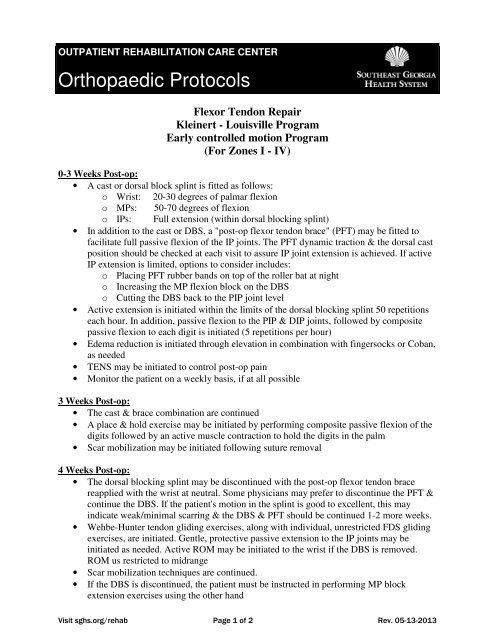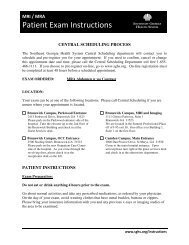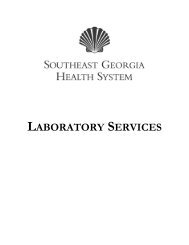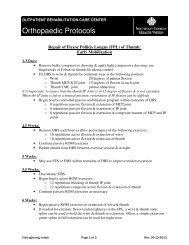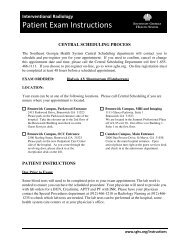Create successful ePaper yourself
Turn your PDF publications into a flip-book with our unique Google optimized e-Paper software.
OUTPATIENT REHABILITATION CARE CENTER<br />
<strong>Orthopaedic</strong> <strong>Protocols</strong><br />
Flexor Tendon Repair<br />
Kleinert - Louisville Program<br />
Early controlled motion Program<br />
(For Zones I - IV)<br />
0-3 Weeks Post-op:<br />
• A cast or dorsal block splint is fitted as follows:<br />
o Wrist: 20-30 degrees of palmar flexion<br />
o MPs: 50-70 degrees of flexion<br />
o IPs: Full extension (within dorsal blocking splint)<br />
• In addition to the cast or DBS, a "post-op flexor tendon brace" (PFT) may be fitted to<br />
facilitate full passive flexion of the IP joints. The PFT dynamic traction & the dorsal cast<br />
position should be checked at each visit to assure IP joint extension is achieved. If active<br />
IP extension is limited, options to consider includes:<br />
o Placing PFT rubber bands on top of the roller bat at night<br />
o Increasing the MP flexion block on the DBS<br />
o Cutting the DBS back to the PIP joint level<br />
• Active extension is initiated within the limits of the dorsal blocking splint 50 repetitions<br />
each hour. In addition, passive flexion to the PIP & DIP joints, followed by composite<br />
passive flexion to each digit is initiated (5 repetitions per hour)<br />
• Edema reduction is initiated through elevation in combination with fingersocks or Coban,<br />
as needed<br />
• TENS may be initiated to control post-op pain<br />
• Monitor the patient on a weekly basis, if at all possible<br />
3 Weeks Post-op:<br />
• The cast & brace combination are continued<br />
• A place & hold exercise may be initiated by performing composite passive flexion of the<br />
digits followed by an active muscle contraction to hold the digits in the palm<br />
• Scar mobilization may be initiated following suture removal<br />
4 Weeks Post-op:<br />
• The dorsal blocking splint may be discontinued with the post-op flexor tendon brace<br />
reapplied with the wrist at neutral. Some physicians may prefer to discontinue the PFT &<br />
continue the DBS. If the patient's motion in the splint is good to excellent, this may<br />
indicate weak/minimal scarring & the DBS & PFT should be continued 1-2 more weeks.<br />
• Wehbe-Hunter tendon gliding exercises, along with individual, unrestricted FDS gliding<br />
exercises, are initiated. Gentle, protective passive extension to the IP joints may be<br />
initiated as needed. Active ROM may be initiated to the wrist if the DBS is removed.<br />
ROM us restricted to midrange<br />
• Scar mobilization techniques are continued.<br />
• If the DBS is discontinued, the patient must be instructed in performing MP block<br />
extension exercises using the other hand<br />
Visit sghs.org/rehab Page 1 of 2 Rev. 05-13-2013
Flexor Tendon Repair/Kleinert - Louisville Program/Early controlled motion Program (For Zones I - IV)<br />
5 Weeks Post-op:<br />
• The PFT &/or DBS are continued if the motion is easy to achieve & there is little<br />
peripheral scarring. The PFT &/or DBS may be discontinued if limited ROM is present &<br />
there is present & there is dense scarring. All tendon gliding exercises are continued as<br />
outlined in Week 4<br />
• If the PFT is continued, it should be removed several times a day to perform the<br />
midrange wrist flexion & extension exercises. If the PFT & DBS are discontinued,<br />
unrestricted AROM exercises are permitted to the wrist & digits.<br />
6 Weeks Post-op:<br />
• The PFT &/or DBS are discontinued, if not already done so.<br />
• If extrinsic flexion tightness is noted, static progressive &/or dynamic splinting may be<br />
initiated to increase finger flexion & extension<br />
• Unrestricted AROM exercises are permitted. Gentle, isolated blocking exercises may be<br />
initiated to facilitate FDS & FDP gliding. The aggressiveness with the blocked motion<br />
should gradually be increased. Patients that easily achieve isolated blocking should<br />
provide a light effort with blocking. Those individuals with dense adhesions & limited<br />
ROM may utilize greater force with the blocking. Gentle, passive extension exercises<br />
may be initiated.<br />
• NMES may be initiated to facilitate FDS &/or FDP tendon gliding. This decision is based<br />
on the nature of injury, the patient's past medical history, current ROM & the strength of<br />
the repair.<br />
• Light functional activities may be initiated.<br />
• Scar management is continued<br />
7 Weeks Post-op:<br />
• Static &/or dynamic splinting may be continued to resolve any residual extrinsic tendon<br />
tightness or joint contracture.<br />
• Scar management should be continued<br />
• Unrestricted active & PROM exercises are continued<br />
• NMES is encouraged with patients demonstrating limited ROM<br />
• Gentle progressive use of the hand is encouraged<br />
• Progress to light grip & wrist strengthening<br />
8-12 Weeks Post-op:<br />
• Progress ROM & gentle strengthening exercises<br />
• Progressively advance to a work conditioning program, including work simulation<br />
activities<br />
• Address ADL &/or work limitations<br />
Considerations<br />
• It is important to respect inflamed tissues & adjust the therapy program accordingly.<br />
Therapy should be less aggressive with exercises with edemations digits. This is<br />
particularly true during the 1st & 2nd week following surgery<br />
• Grip & pinch strength testing is delayed until 12 weeks post injury to prevent any<br />
possible rupture<br />
• Typically, at 12 weeks, the patient may return to normal, unrestricted functional<br />
activities. The physician will make this determination.<br />
Visit sghs.org/rehab Page 2 of 2 Rev. 05-13-2013


